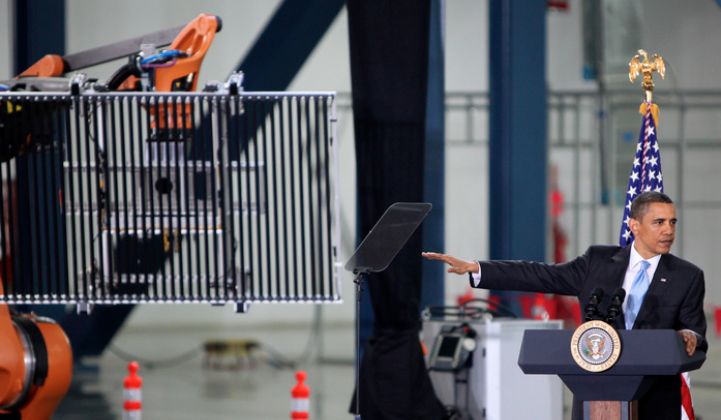Today, when Department of Energy officials talk about the embattled loan guarantee program for clean energy, they bring the same kind of confidence that President Obama first displayed when touring the Solyndra factory in 2010.
“It’s a portfolio that JPMorgan and others would be glad to hold," said John MacWilliams, a senior advisor to the energy secretary, speaking at an event last month in Boston.
Former Energy Secretary Steven Chu, who received the bulk of political fire from Republicans after the bankruptcy of Solyndra and other companies supported by the loan program, made similar statements upon leaving office: "We were more successful than Wall Street. So come on, guys."
Why are these men feeling so emboldened after being on the defensive for so many years about supporting a handful of companies that went bankrupt?
Because the program is officially making money for taxpayers, according to the DOE.
As documented in a new progress report from DOE, the government has netted $30 million in loan guarantee interest payments since it first started supporting clean energy manufacturers and developers.
A $30 million profit after three years hardly makes it more successful than Wall Street, as Chu claimed. But it certainly makes it more successful than many venture capitalists who saw big losses in cleantech between 2010 and 2013.
It's also political ammunition for the DOE, which faced sustained attacks from Republicans trying to make the Solyndra bankruptcy into an election-year issue.
When all loans are paid back, the government says it could ultimately net up to $6 billion for taxpayers.
The federal loan guarantee program was created in 2005 with support from the Bush administration in order to speed the commercialization of clean energy projects or manufacturing processes. Rather than investing directly in companies, the government guaranteed their debt by backstopping any defaults. In theory, this ensured that private lenders would support emerging companies and help them cross the "valley of death."
It wasn't until Congress authorized billions of dollars for loan guarantees in the 2009 stimulus package that the lending got fully underway.
Three years and more than $15 billion later, the program hailed as a lifeline to the clean energy industry started facing serious scrutiny. First, Solyndra, which received a $535 million loan guarantee, went bankrupt. And then came a cascading series of failures: A123 Systems, Abound Solar and Fisker Automotive all imploded.
Those failures, says DOE, cost taxpayers $780 million. But the broader portfolio of clean energy loans has reaped $810 million in interest payments -- putting the taxpayers in the black.
"Taxpayers are not only benefiting from some of the world's most innovative energy projects...but these projects are also making good on their loan repayments," said Peter Davidson, executive director of the loan programs office, said in an interview with Reuters before the report was released.
Last May, Tesla became the first company to pay back its $465 million loan in full -- just a year after Mitt Romney called the company a "loser."
The DOE has always contended that its portfolio-wide approach, which includes a wide variety of projects with varying degrees of risk, would be a net positive for taxpayers. Officials say the program has a 98 percent success rate so far, and they don't expect very many more losses to come.
When Congress initially funded the program, it appropriated $10 billion for failures. Eventual losses could reach $2 billion -- only a fifth of what was expected. Ultimately, the government expects to net more than double those losses after all loan payments are made.
In an email, Jonathan Silver, the former executive director of the loan programs office, said the result was "exactly as the program staff projected."
Silver said the report vindicated the DOE's portfolio approach. "Now the facts speak for themselves," he said. "This is also a reminder that politicians would be well advised to be more prudent in their comments before all the facts are known."



